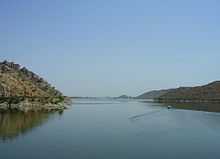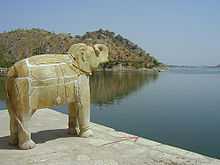Dhebar Lake
| Dhebar Lake | |
|---|---|
| Location | Udaipur District, Rajasthan |
| Coordinates | 24°16′N 74°00′E / 24.267°N 74.000°ECoordinates: 24°16′N 74°00′E / 24.267°N 74.000°E |
| Lake type | reservoir |
| Primary inflows | Gomati River |
| Primary outflows | Gomati River |
| Basin countries | India |
| Max. length | 9 mi (14 km) |
| Surface area | 87 km2 (34 sq mi) |
| Max. depth | 102 ft (31 m) |
| Shore length1 | 30 mi (48 km) |
| Islands | 3 Islands |
| 1 Shore length is not a well-defined measure. | |
Dhebar Lake (also known as Jaisamand Lake) is Asia's second-largest artificial lake (is considered largest now, since the Upper lake in Bhopal, India is the largest artificial lake in Asia, but is almost dried up due to lack of rainfall). It is located in the Udaipur District of Rajasthan state in western India. It has an area of 87 km2 (34 sq mi) when full, and was created in the 17th century when Rana Jai Singh of Udaipur built a marble dam across the Gomati River. It is 45 km from District headquarters of Udaipur. When first built, it was the largest artificial lake in the world. The surrounding Jaisamand Wildlife Sanctuary around Dhebar Lake can be reached by the state highway to Banswara from Udaipur. It is 27 km from Parsad (A village on National Highway No. 8). The Jaisamand Wildlife Sanctuary protects 162 km², mostly teak forest, on the shores of Dhebar Lake. The lake has a total number of 3 islands measuring from 10 to 40 acres (160,000 m2) each. The Dhebar Lake Marble Dam is 300 Meters long and is a part of the "Heritage Monuments of India". The dam also has the Hawa Mahal Palace, winter Capital of the erstwhile Maharanas of Mewar.

Dhebar Lake, built by Maharana Jai Singh in 1685, is the second biggest artificial lake in the world covering an area of 36 square miles (93 km2). The lake remained the largest artificial lake in the world till the building of the Aswan dam in Egypt by the British in 1902, that was reconstructed between 1960-1970. During the reign of Maharana JAI SINGH (1680–1698), there was a great need for water for cultivation in Mewar's southeastern corner. The Maharana emulated his father (Maharana RAJ SINGH I who built RAJSAMAND LAKE) by damming a small river, the Gomati, and building a massive embankment; the height of the dam is 36.6 meters. Jai Singh named the resultant lake JAISAMAND after himself - its often-used nickname is 'Ocean of Victory' ('mand' meaning 'ocean'). On the day of its inauguration, June 2, 1691, Maharana Jai Singh walked around the dam charitably distributing gold equal to his own weight. The statistics of the lake is really amazing – 9 miles (14 km) in breadth, 102 feet (31 m) deep at its deepest end, a circumference of 30 miles (48 km), with marble staircases leading into the water. The summer palaces of the Queens of Udaipur surround Dhebar Lake on all sides.
There are 3 islands on Dhebar Lake, and the tribe of Bhil Minas (see People of Rajasthan) inhabits all. The two bigger islands are known as Baba ka Magra and the smaller island is called Piari. There is a bund on the lake, which has to be mentioned due to its sheer size – 1,202 feet (366 m) long, 116 feet (35 m) high and 70 feet (21 m) broad at the base. On the marble dam are six exotic cenotaphs and a Shiva temple in the centre. The northern end of the lake has a palace with a courtyard while its southern end has a pavilion of 12 pillars. The hills to its south have grand palaces that have an excellent view of the lake.
Dhebar Lake has elegant steps leading to the water and marble Chhatri (cenotaphs) on its bank with a small Shiv temple that marks the grace of the lake.

On either side are the palaces built for the past kings favourite queens. The local tribe "Bhils" still inhabit the islands. Maharaja Jai Singh created Dhebar Lake in the 17th century utilizing the waters of the Gomti River. Encircled by hills and with a number of summer palaces along the shore, the lake is a natural and peaceful haven. There are eleven islands on the lake, some of which provide sanctuary inhabited by several species of migratory birds. The nearby wildlife sanctuary is also worth a visit. There is a number of resort hotels catering for those who would appreciate a break from the noise and turnoil of the city. Maharana Jai Singh at the time of digging the foundation for Dhebar Lake, celebrated the occasion by giving away gold in charity after a Tuladaan Ceremony. In the lake there are three islands whose inhabitants use Bhels (boats) to reach the shore. On the top of two nearby hillocks are two old palaces constructed by Maharana Jai Singh still exist in great condition. A very fine view of the lake is available from these Great Palaces. Graceful marble chhatris flank the embankment and beautiful summer palaces of the Udaipur queens.
A trip to Jaisamand Wildlife Sanctuary allows a close encounter with the rich wildlife in their natural habitat. The fauna includes panther, wild boar, deer, four-horned antelope, mongoose and various species of migratory birds.
See Also
- Arid Forest Research Institute
- List of lakes in India
| ||||||||||||||||||||||